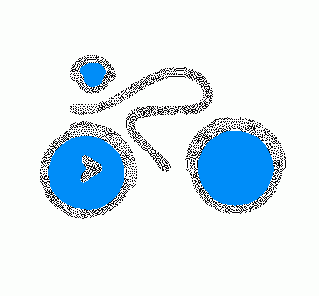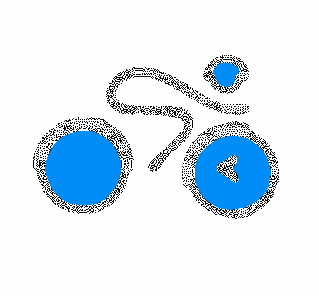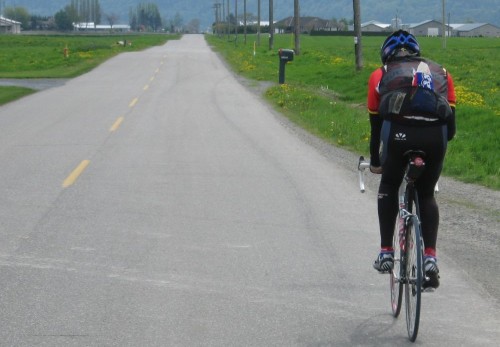| Newsletter - 2009 Archive |
 |
Cycling Club |
 |
| Newsletter - 2009 Archive |
 |
Cycling Club |
 |
Next--->
 Here's Luis on his fixed gear bike on the recent Ryder Lake 300. The route includes Nicomen Island... OK, the photo is not from Nicoman Island. Let's just pretend. Photo: Deirdre/Bob Pondering Bike Myths on Nicomen Island Nicomen Island, the 9.5 km stretch of Hwy 7 between Dewdney and Deroche, has got to be the dullest, most mind-numbing piece of boring landscape in all of BC. How can less than 10 km feel like more than 10 miles? One of my favourite rides is from Burnaby to Harrison Hot Springs. A friend drives out and meets me there, and we soak in the hot tub before putting the bike in her car and driving back. I enjoy the climbs on Dewdney Trunk and the swooping descent into Ruskin. The final push over Woodside is satisfying, knowing I'm almost there. But the part I abhor is Nicomen Island. Riding this section solo is not fun. It's not the traffic, although it's usually medium-light, with platoons of vehicles whizzing by at the typical BC 10-20 kmh over the limit. It's also not the wind on this flat, exposed stretch that suggests a pace line would alleviate the constant breeze as well as the pervasive boredom. I think what I don't like about it is what Gertrude Stein once said. No, not the line about how fish need bicycles. What she said about my hometown of Oakland, CA: "There's no there there." There is nothing on Nicomen Island! I spent a large portion of my cycling life riding in circles on velodromes around North America and the Caribbean. You might think this should be boring, but usually you are in a pace line, training at around 40 kmh and racing at around 50 kmh, so you don't really have time to be bored, even when you're circling the track for over an hour in training. But riding by yourself on the track, that's dull. And it feels the same riding over Nicomen Island alone. The best use for stretches of road like Nicomen Island is to achieve quality meditative states, or to ponder great philosophical questions: Here's one: have you ever considered whether it is more efficient to ride in a given gear in a large chainring/large rear cog or in a small chainring/small rear cog combination? Take 75 inches, for example. You can do this in 53x19 (75.3") or 39x14 (75.2"). You'd think they should feel the same, right? In track racing, there is a supposed old wives' tale: sprinters should use a small chainring/small cog combination because it accelerates faster; pursuiters should use a big ring/big cog combo because it's easier to keep it rolling. Sounds like folklore to most people. But here on Nicomen Island, you can not only think about it, you can put it to the test. Let's say you are spinning at 120 rpms. (An aside: if you want to win medals in pursuits, learn to spin a 90" gear at 120 rpms for four to five minutes - that's all it takes!) This is two pedal revolutions per second. The chain has to travel at the same speed as the chainring: 53 times 2 links per second (106 links per second) or 39 times 2 (78 links per second). Think about that… in a small/small combination, to get from 0 to 120 rpms, you only need to accelerate that heavy length of chain to about 75% of the speed it would need to go with the big/big combination. But, once you've got the chain moving, you've got this heavy chain maintaining your momentum 36% faster in the big/big combination than in the small/small. How do you apply this to randonneuring? Well, for one thing, climbing is merely one long acceleration. If you can get by with a slower-moving chain for the same speed, always climb in your smallest ring. Once you are on the flats, though, and up to speed, pop it into the big ring and use a big cog in back so you are not overgeared. Another factor to consider is crank length. Riders often equate crank length to leg length, thinking that those with longer legs need longer cranks. Or they think that a longer crank lets you climb in a bigger gear because you have more leverage. This may be true, but you should also think of the downside of a longer crank: for a given pedal rpm, your foot needs to travel faster. This is because you measure speed in two ways around a circle: you can measure angular velocity - how many times you go around the circle in a given time, like rpm's. You can also measure simple linear velocity - rpm's times the circumference of the circle. So, the bigger the circle (longer the crank) for a given angular velocity, the faster the linear velocity. The reason track riders use shorter cranks (like 165's) is not just to avoid scraping the pedal on the banking. It's so that their feet don't have to move as fast at the high pedal cadences used on the track! With a fixed gear on the road, this comes in handy on descents. You can spin at really high cadences, but the actual speed the foot is going is maybe 3% slower per 5 mm of crank length (I was lousy at physics and I forget how I calculated that). Personally, I think for most people on geared bikes crank length tends to be a wash; you don't really notice it, especially if you have long legs. Where it might become important is on a tandem, where you have an experienced driver and an inexperienced stoker. The pilot wants to spin, the stoker likes to plod. So you put 175's on the front and 165's on the back. The front requires more linear foot speed to achieve the same spin, the stoker is a bit more comfortable at a slightly higher rpm because the foot doesn't need to move as fast. Another good place for longer cranks is here on Nicomen Island, grinding a big gear on the big ring and taking advantage of the extra leverage to get the cranks around. When I rode flat time trials, I would sometimes turn 180mm cranks. This might be a good strategy here. Instead of chipping away at Nicomen in a small gear, take big chunks and get it the heck over with.
- May 12, 2009 |